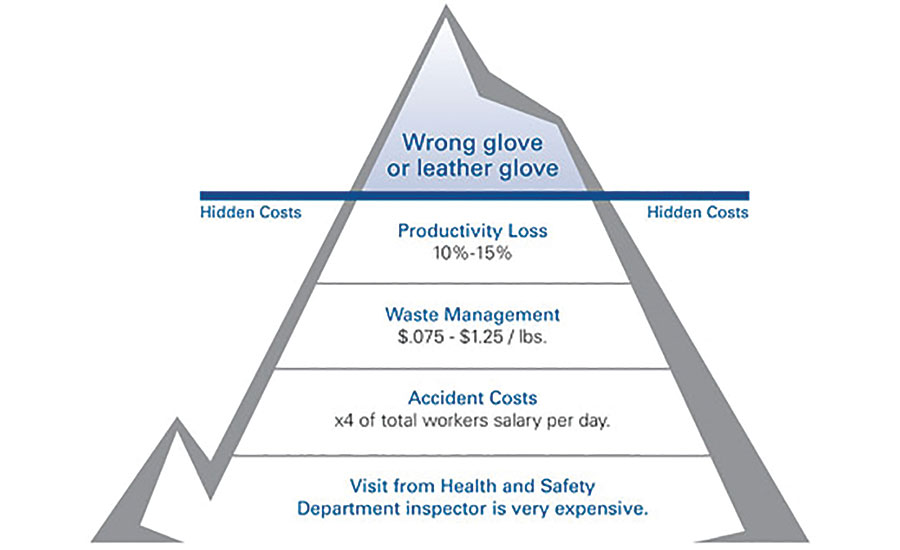Do you really have the best gloves for the job?

Figures courtesy of Superior Glove.

Figures courtesy of Superior Glove.


What do the RMS Titanic and wearing improper PPE have in common?
Unfortunately, in both situations, those involved aren’t always aware of the threat of impending danger until it’s too late.
Here’s the good news: accidents caused from workers wearing the wrong PPE for the job are extremely preventable – provided, that is, that the right precautions are taken.
Do you remember the days when leather gloves were the only option available on the market? There’s a reason why the style and variation of work gloves have evolved over the years: with all of the technological advancements and high quality materials on the market, these days, glove manufacturers are able to design work gloves that offer sizable benefits to workers in certain applications and industries. Because of this, it’s important to opt for a glove that was specifically made to suit the needs of the job and protect hands against the related work hazards.
Translation: one glove does not fit all. Seems obvious, right?
Still wearing the wrong glove
Believe it or not, when glove experts perform hand safety assessments, one of the biggest problems they find is that workers aren’t wearing the right gloves. This is often because both employers and employees are unaware that they’re exposing themselves to such high risks by wearing gloves that were actually designed for other applications.
While those who haven’t experienced a recent increase in the number of hand injuries in their workplace are unlikely to question whether or not they’re wearing the right gloves,, in actuality, this is extremely important. Although employees might feel a little attached to the gloves they’ve grown used to wearing, it’s no secret that wearing the wrong gloves has a direct correlation with the number of accidents in a workplace, as well as with their level of severity.
Continuing with the Titanic metaphor, this is what we like to refer to as “The Iceberg Effect.”
Although wearing the wrong glove might not seem like a big deal at the time, in reality, it’s the tip of the iceberg – one that spans the length of several ocean floors, and that is chockfull of unnecessary dangers and expensive hidden costs.
It’s pretty frightening when you think about it that way, isn’t it? So, what can you do to alleviate this problem?
Establish an effective PPE program
Partner with a safety specialist, and ask them to perform an audit of your workplace. Ask them to take into account the various hazards that workers will face when they’re on the job, as well as the nature of the PPE that workers are currently wearing.
Could they benefit from wearing gloves that offer a little more cut protection? Is abrasion a concern? Do they need a stronger grip in oily work conditions? These – along with any other questions that relate to the worker’s ability to get the job done in an effective but safe manner – should all be taken into consideration. That way, the safety specialist can ensure that the selected PPE addresses both the demands of the job as well as the various risks in the workplace.
Still not convinced why it’s so important to ensure that everyone is wearing the best gloves for the job? Maybe these hand injury statistics will convince you: According to the pie chart, on average, about 23 percent of workplace accidents are hand-related.
This means that switching to gloves that are more suitable for your application/industry could not only minimize the number of accidents in your workplace, but also save your company money in the long run. Basically, it’s a win-win for everyone involved.
Reduce waste; increase productivity
Ensuring that workers are wearing the right gloves can also stand to reduce the amount of PPE waste that your facility produces, but it can even increase worker productivity and compliance: the better-suited the gloves will be to the task at hand, and, because of this, the more likely it’ll be that your workers will want actually want to wear them. And, if you’re interested in saving your company even more money when it comes to PPE costs, establishing a laundering program will prevent you from having to replace your gloves nearly as often.
Ensuring that your employees are safe in the workplace really is a requirement – rather than a choice. Section 1910.138 of OHSA states that employers must select and require employees to use appropriate hand protection when their hands are exposed to any of the following: skin absorption of harmful substances, chemical burns, severe cuts and lacerations, thermal burns and harmful temperature extremes, and severe abrasion and puncture threats.
So, if you’re wondering if it’s worth the time and money it’ll take for you to re-evaluate your current PPE selections and whether or not they’re the best choice for your industry, the short answer is, yes, it’s more than worthwhile. As you can see, implementing a proper hand protection program in your workplace isn’t just a good idea – it’s critical.
Not sure if your workers are wearing the best gloves for the task at hand? Ask a glove expert: they’d be happy to give you a few recommendations.
Looking for a reprint of this article?
From high-res PDFs to custom plaques, order your copy today!






